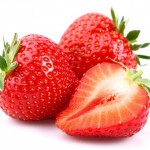Strawberries are in season in Britain through the summer months from June to August. Ripe strawberries taste sweet and are used widely in many desserts – they make a delicious snack on their own too. They are full of Vitamin C and are a good source of fibre.
Try this no-cook, quick and easy dessert in summer - or vary the fruit depending on the season. In winter use frozen or tinned fruit - it still counts towards your 5-a-day.
Skills Check
Follow a recipe; follow food safety & hygiene rules; tidy away; use measuring spoons; use weighing scales; chop using bridge/claw technique safely; beat ingredients together; garnish and decorate.
Allergens
Wheat | Gluten | Milk
(please note the allergens listed are indicative only. Allergens vary depending on brand; check the labels on the products you use)
Equipment
Food bag, knife, chopping board, bowl, spoon, serving glasses or clear plastic cups, measuring spoons, weighing scales.
Ingredients (serves 4):
- 200g strawberries
- 150g fat free plain yoghurt
- 100g fat free fromage frais
- 5 plain digestive biscuits
- 1 tbsp runny honey
Method
- Put the digestive biscuits in a food bag, and using your fists press into small pieces. Pour a layer of the crumbled biscuits into the bottom of each glass.
- Chop strawberries into small chunks and add a layer on top of the biscuit crumbs in each glass. Keep a few strawberries in reserve for decoration.
- Mix the yogurt, fromage frais and honey and add a layer to each of the glasses.
- Finish off the dessert by decorating with a few strawberry pieces.
So thinking about strawberry cheesecake ...

Yogurt is an excellent source of calcium, and a good source of vitamin D for strong teeth and bones.
Fromage Frais is a type of smooth, fresh, soft cheese with the consistency of thick yogurt. It is an excellent source of protein and calcium.
Biscuits tend to be high in fat and sugar. We should try to eat these types of foods less often and in small amounts.
Nutritional Information
| - | Energy | 580kJ / 138kcal | 7% |
| Low | Fat | 3.4g | 5% |
| Low | Saturates | 1.5g | 8% |
| Med | Sugars | 12.4g | 14% |
| Low | Salt | 0.3g | 6% |
per 133g serving
% of an adult's reference intake
Typical values per 100g: Energy 436kJ / 103kcal
Notes
A traffic light system is used on nutrition labels to make it easier to see which foods and drinks are lower in calories, fat, sugar and salt. Try and choose more ‘greens’ and ‘ambers’ and fewer ‘reds’, and stick to smaller portions of ‘reds’.
Just because a recipe or a food has a red traffic light doesn’t mean you shouldn’t eat it. Understanding why a food or recipe might have a red light can be helpful. For example oily fish is high in total fat and so any recipe containing oily fish is likely to be ‘red’ for fat. But it is recommended that we eat oily fish at least once a week because the type of fat it contains is beneficial for our health.
% Reference Intakes are also shown. Reference Intakes are guidelines about the approximate amount of particular nutrients and energy required for a healthy diet (based on an average-sized woman doing an average amount of physical activity). Most children will require less than these Reference Intakes. The contribution of one serving of a food or drink to the Reference Intake for each nutrient is expressed as a percentage.




